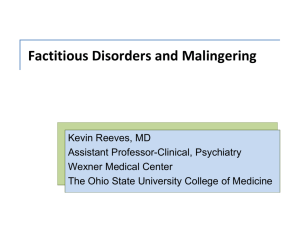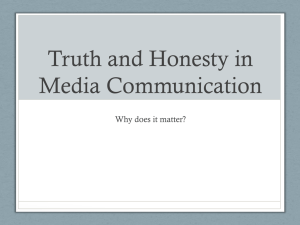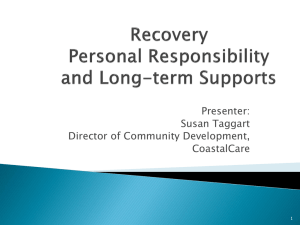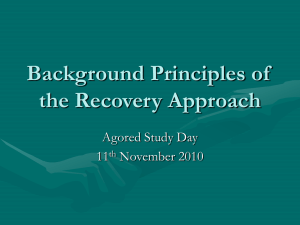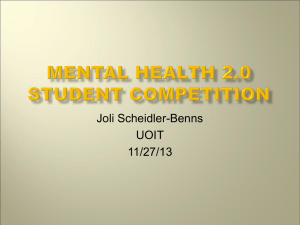here - Trent Occupational Medicine Annual Symposium
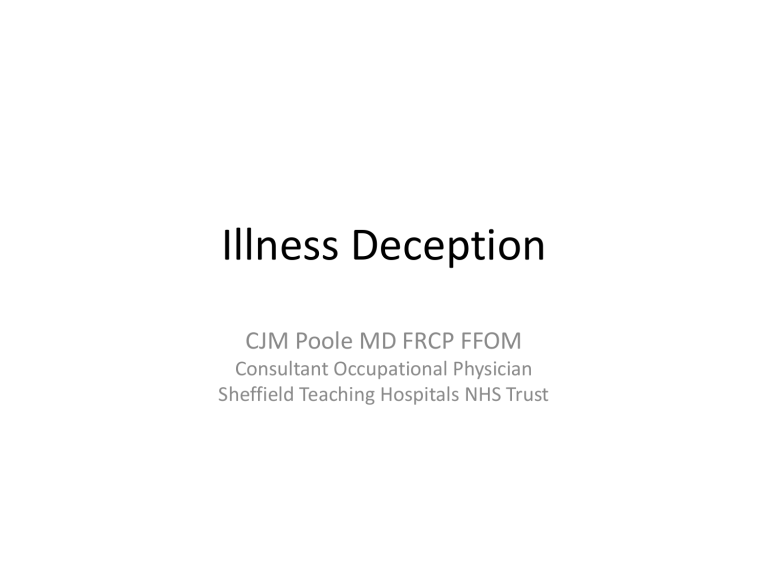
Illness Deception
CJM Poole MD FRCP FFOM
Consultant Occupational Physician
Sheffield Teaching Hospitals NHS Trust
Definitions
• Malingering – feigning, gross exaggeration or self-induction of symptoms, signs or disability for substantial material gain. Conscious and intentional.
An adaptive behaviour that may wax and wane. Limitations of DSM-IV. Not an illness, so not a diagnosis.
• Factitious Disorder – ditto, but motive is a psychological need to adopt the sick role. Conscious and intentional, but motive may be poorly understood. May submit to surgery, radiotherapy, chemotherapy, forge medical reports, self-inject, venesect, abuse laxatives or diuretics, rashes, haematuria. Often women linked to health care jobs. Need for love or sympathy at times of stress, maladaptive response to previous trauma.
Illness.
• Munchausen’s syndrome – Asher. Hospital EDs with fanciful stories.
Abscond. ASBO. Illness.
Definitions continued
• Munchausen syndrome by proxy (MBP/FII by Carers) – Meadow. Usually a mother, but may be a HCW eg Beverley Allitt. Suffocate, poison, interfere with treatment. Abuse.
• Munchausen by internet – deception of virtual friends. Website –
Proud2bMunchausen
• Non-organic (functional) illness – no biomedical explanation. Medically unexplained symptoms
• Non-credible, not disclosed, sub-maximal effort
• Somatoform Disorder – physical symptoms for which there is no physical explanation, that fails to respond to reassurance, in association with marked anxiety or depression
• Dissociative (Conversion) Disorder – hysterical conversion. Motivation unknown by patient and unconscious. Motor or sensory response to emotional distress. fMRI – cortical and limbic activations similar to those seen in hypnosis (ref Cojan Y et al. Neuroimage 2009; 47: 1026-1037)
How common is illness deception?
• Depends on context – 30 to 40% in forensic or medico-legal settings
• Successful malingerers are likely to repeat behaviour eg become accident prone and serial litigants
• £800 million per year spent on fraudulent or erroneous benefit claims in
UK
• Costly to health care – case report of a patient having16 bronch-oscopies for factitious haemoptysis (Baktari JB et al Chest 1994)
• 32/400 (8%) of my patients (13% had an occupational illness) Occ Med
2010; 60:127-132
• May occur in epidemics eg railway spine, repetitive strain disorder in
Australia, ‘whiplash’
• Illnesses that rely on subjective symptoms are easiest to simulate
• Non-organic component to all illnesses
• Most doctors are not prepared for patient deception
How do I detect it?
• Circumspect and analytical approach
• Identify materially relevant incongruencies in history, examination or investigation. (There may be a need for additional tests, old medical records, covert surveillance)
• From the history and context what is the likely motive?
• Is the secondary gain internal (FD) or external (M)?
• Is the behaviour conscious (FD) or unconscious (dissociative)?
Are there any useful signs or tests?
• Waddell’s behavioural signs for back pain (Spine 1980)
• High CV (> 20%) for three consecutive maximal grip strengths (Poole
CJM Occ Med 2010)
• Eyes closed sign (Gray DWR et al BMJ 1988)
• Hoover’s sign (JAMA 1908)
• Coin-in-the-hand test (Kapur N J Neurol Neurosurg Psych 1994)
• Screening for laxatives, insulin, C-peptide, hypoglycaemic tablets, steroids and blood type
• Symptom validity (effort) testing
Subjects
Normal
RAs n
100
69
Right hand
Mean grip (kgf) SD
38.7
17.8
11.1
5.9
Mean CV
5.8
7.4
Median CV
5.2
5.4
90th centile CV 95th centile CV
10.5
14.5
12.5
20.4
3
4
5
6
1
2
Patient Sex
Age
(years)
Female 53
Female 51
Male
Male
27
54
Female 45
Male 55
Right hand (kgf)
SD
18, 10, 10 4.62
20, 12, 10 5.29
30, 34, 42 6.11
16, 10, 24 3.06
26, 34, 40 7.02
19, 16, 24 4.04
CV%
36.5
37.8
17.3
22.9
21.1
20.5
18
10
10
4.6188
12.666
0.3646
Symptom Validity Testing
• Developed by neuropsychologists to evaluate reported cognitive or psychological symptoms
• Test of Memory Malingering (TOMM), Word Memory Test (WMT),
Structured Interview of Reported Symptoms (SIRS), Minnesota Multiphasic
Personality Inventory (MMPI-2)
• Include rare or unlikely symptoms, answers compared with subjects not seeking compensation, or with normal subjects feigning impairment
• Low scores worse than chance, improbable or highly variable responses
• Positive and negative predictive power for MMPI-2 of 84 and 91%
• More than one method should be used when assessing a patient
• 233 German litigants & benefit claimants for head injuries - 45% failed
SVTs (Stevens A et al Psychiatry Res 2008)
• 72 patients with fibromyalgia – 36% failed SVTs (Brooks L et al Clin
Neuropsychol 2012)
• 73 patients with CRPS-1 seeking disability payments – 75% failed one of the SVTs ( Greiffenstein M et al Clin Neuropsychol 2013)
Ethical and legal considerations
• Confidentiality must be respected, but not if there is significant risk of harm to others, or serious fraud
• Contractual duty to third party v Duty of Care to patient
• Bolam test of negligence
• Covert surveillance is permissible but must comply with Regulation of
Investigatory Powers Act
• Patient must consent to room or belongings being search in UK, but not in
USA
FLT driver in a factory diagnosed with occupational asthma at a regional centre.
Personal injury litigation in progress. Very little absence, works overtime, never seen to be ill at work or in clinic. Grossly abnormal PEFRs (650 – 60 l/min).
Normal spirometry on 12 separate days in five locations.
56 year old labourer diagnosed with HAVS 3V 3SN after standardised tests.
Working, driving, plays darts, holidaying abroad. Previous litigation for back pain. Reports no sensation to light touch, pin prick, vibration and joint position sense in fingers both hands, CV grip strength 21% right and 20% left hands
55 year old teacher seeking ill health retirement on grounds of deafness. Prescribed hearing aid after ENT consultation. Normal conversation in clinic and during audiometry testing
How should patients be managed and letters written?
• Little risk of self-harm but greater risk of a complaint
• Statements should be objective and non-judgemental
• No need to make reference to motive or volition
• State there are inconsistencies in the history, examination or investigation of the patient
• Say the patient is more impaired/ disabled that I would expect
• Give patient an opportunity to explain discrepancies (draft report)
• Do not collude with malingering and thereby assist with secondary gain
• Say the diagnosis is questionable or the cause is unknown
• Avoid using the terms malingering, fraud, functional
• Those with factitious disorder need psychological support, but frequently default from follow-up
• MBP discuss with hospital multi-disciplinary child protection team or refer to LA’s duty social worker who will liaise with police


![Illness deception [revised version]](http://s3.studylib.net/store/data/008285672_1-42f007d9a78e6271ab46672f4d7f9064-300x300.png)

